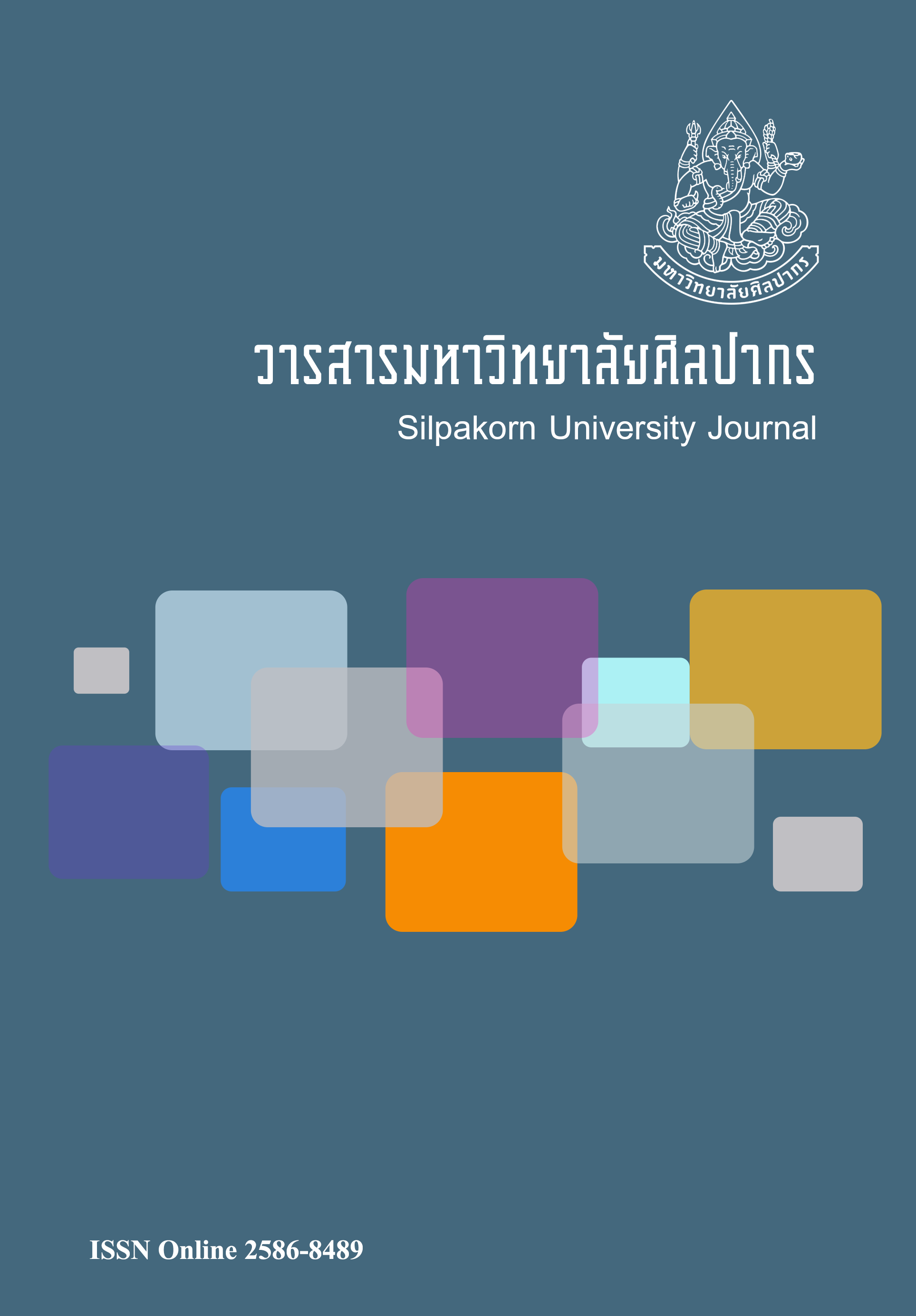ปัจจัยคัดสรรที่ส่งผลต่อการดำเนินงานตามระบบดูแลช่วยเหลือนักเรียนของสถานศึกษา สังกัดสำนักงานเขตพื้นที่การศึกษามัธยมศึกษา เขต 3 จังหวัดพระนครศรีอยุธยา (Selected Factors Affecting the Performance of Student Assistance System in Schools under Secondary Educational Service Area Office 3 in Ayutthaya Province)
Main Article Content
Abstract
การวิจัยนี้มีวัตถุประสงค์เพื่อศึกษา 1) ระดับของปัจจัยคัดสรร 5 ด้าน คือ ภาวะผู้นำใฝ่บริการของผู้บริหาร ความพร้อมของบุคลากร การทำงานเป็นทีม ระบบข้อมูลสารสนเทศ Scan Tool 3 การนิเทศ กำกับ ติดตามและประเมินผลการดำเนินงานตามระบบดูแลช่วยเหลือนักเรียน 2) ระดับการดำเนินงานระบบดูแลช่วยเหลือนักเรียน และ 3) ปัจจัยคัดสรรที่ส่งผลต่อการดำเนินงานระบบดูแลช่วยเหลือนักเรียน
ตัวอย่างในการวิจัย คือ ผู้บริหารและครูผู้สอน สังกัดสำนักงานเขตพื้นที่การศึกษามัธยมศึกษา เขต 3 จังหวัดพระนครศรีอยุธยา จำนวน 110 คน ที่ได้จากการคำนวณโดยโปรแกรมสำเร็จรูป G*Power เครื่องมือที่ใช้เป็นแบบสอบถามจำนวน 65 ข้อที่มีข้อคำถามเกี่ยวกับปัจจัยคัดสรรและการดำเนินงานตามระบบดูแลช่วยเหลือนักเรียน มีค่าความเที่ยง เท่ากับ 0.962 และ เท่ากับ 0.965 ตามลำดับ สถิติที่ใช้ ได้แก่ ร้อยละ ค่าเฉลี่ย ส่วนเบี่ยงเบนมาตรฐาน การวิเคราะห์สหสัมพันธ์และการวิเคราะห์ถดถอยพหุคูณแบบนำตัวแปรทั้งหมดเข้าสมการ
ผลการวิจัยพบว่า 1) ปัจจัยคัดสรรในการดำเนินงานตามระบบดูแลช่วยเหลือนักเรียนโดยภาพรวม อยู่ในระดับมาก เมื่อพิจารณาแต่ละด้าน พบว่า การทำงานเป็นทีม อยู่ในระดับมากที่สุด รองลงมาคือ ความพร้อมของบุคคล การนิเทศ กำกับ ติดตาม และประเมินผล และภาวะผู้นำใฝ่บริการของผู้บริหาร อยู่ในระดับมาก ตามลำดับ ส่วนระบบข้อมูลสารสนเทศ Scan Tool 3 อยู่ในระดับปานกลาง 2) การดำเนินงานตามระบบดูแลช่วยเหลือนักเรียน โดยภาพรวมและรายด้านอยู่ในระดับมากและ 3) ปัจจัยคัดสรรที่ส่งผลต่อการดำเนินงานตามระบบดูแลช่วยเหลือนักเรียน เรียงตามลำดับ ได้แก่ การทำงานเป็นทีม การนิเทศ กำกับ ติดตามและประเมินผล ภาวะผู้นำใฝ่บริการของผู้บริหาร ร่วมกันพยากรณ์การดำเนินงานตามระบบดูแลช่วยเหลือนักเรียน ได้ร้อยละ 69.10
The purposes of this research were to study: 1) the level of 5 selected factors including administrators’ servant leadership, staff preparedness, qualifications of professional teachers, teamwork, the Scan Tool 3 information system, and supervision, follow-up and evaluation of student assistance system performance; 2) the performance level of school’s student assistance system; and 3) selected factors affecting the school’s student assistance system performance.
The samples were 110 administrators and teachers under Secondary Educational Service Area Office 3 in Ayutthaya province, which were computed, using the G*Power program. The research instrument employed was a questionnaire with 65 items related to selected factors and school’s student assistance system performance. The reliability was 0.962 and 0.965 respectively. The statistics used for data analysis were percentage, mean, standard deviation, correlation coefficient, and multiple regression analysis (enter method).
The results were as follows. 1) The level of the selected factors of the school’s student assistance system performance was high overall. Considering each factor, the results showed that teamwork was rated the highest whereas qualifications of professional teachers, supervision, follow-up and evaluation, and servant leadership were rated high. The Scan tool 3 information system was at a moderate level. 2) The level of student assistance system performance was high in each aspect and overall. 3) Selected factors affecting the school’s student assistance system performance included, in the descending order of predictive power, strategic factors, teamwork, supervision, follow-up and evaluation, and servant leadership, which cumulatively predicted the internal quality assurance of the schools at the percentage of 69.10.
Downloads
Article Details
References
Khuptikasem, W. (2016). The development of learning outcome on the topic, “leading consonant” and communication skill for the first grade student by using balanced literacy teaching. (การพัฒนาผลการเรียนรู้เรื่อง อักษรนำ และทักษะการสื่อสารของนักเรียนชั้นประถมศึกษาปีที่1 โดยใช้การสอนแนวสมดุลภาษา). Veridian E-Journal, 9(2) (May – August, 2017), 1128.
Limthrakan, S. (2004). The basic knowledge of reading (ความรู้เบื้องต้นเกี่ยวกับการอ่าน) (12th ed.). In the use Thai language unit 1-7. Nonthaburi: Sukhothai Thammathirat Open University.
Long, M. H. (1985). A role for instruction of second language acquisition: task-based language teaching. In K. Hyltenstam & M. Peinemann (Eds.). Modelling and assessing second language acquisition (pp. 77-99). Cleve don, England: Multilingual Matters.
Mansetthavit, S. (1994). The principles and methods of teaching Thai reading (หลักและวิธีสอนอ่านภาษาไทย). Bangkok: Thai Watana Panich Co., Ltd.
Moosikkharat, T. & Lumyotphol, T. (2008). The development a efficiency in reading (การพัฒนาสมรรถภาพในการอ่าน) (12th ed.). In the use Thai language units 9-15. Nonthaburi: Sukhothai Thammathirat Open University.
Nunan, D. (1989). Designing tasks for the communicative classroom. New York: Cambridge University.
Posakitsana, P. (1978). The important aspects of Thai language (ลักษณะสำคัญของภาษาไทย). Bangkok: The Secretariat of the cabinet.
Richards, J., Platt, J., & Weber, H. (1986). Longman dictionary of applied linguistics. London: Longman.
Sangphalasit, W. et al. (1976). The usage of language (การใช้ภาษา). Bangkok: Odeon Store.
Somprayoon, W. (2010). Thai language teaching techniques (เทคนิคการสอนภาษาไทย). Bangkok: dokyastore.
Tantiphacheeva, K. (2008). Instructional model for childhood (รูปแบบการเรียนการสอนปฐมวัยศึกษา). Bangkok: Brain-Based Book.
Vonvisit, K. (2008). Language skill for communication (ทักษะภาษาเพื่อการสื่อสาร). Bangkok: Odeon Store.
Willis, J. (1996). A framework for task-based learning. London: Longman.
Yuree, P. (2015). A study of creative writing ability of fifth grade students using the CIRC cooperative technique learning (การศึกษาความสามารถด้านการเขียนเชิงสร้างสรรค์ของนักเรียนชั้นประถมศึกษาปีที่ 5 ที่จัดการเรียนรู้แบบร่วมมือเทคนิค CIRC). Veridian E-Journal, 8(3) (September–December, 2017), 15.


